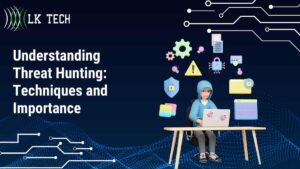The Crucial Role of Threat Hunting in Modern Cybersecurity
Cyber threats are a growing concern for organizations of all sizes. As malware and ransomware attacks surge, proactive cybersecurity measures like threat hunting have become essential. This article will explain what threat hunting is, highlight key techniques, and show why it's critical for security today.

- Understanding Threat Hunting: Techniques and Importance
What is Threat Hunting and Why it Matters for Cybersecurity?
It's refers to proactively searching through an organization's networks, endpoints, and systems to uncover advanced cyber threats that evaded existing security tools. Rather than waiting for an alert, threat hunters take a hypothesis-driven approach to find hidden or emerging attacks.
Threat hunting complements automated defenses like firewalls and antivirus software. It provides vital context around threats to strengthen prevention, detection, and response. With businesses facing rising cyber risks.
The Evolving Threat Landscape
The threat landscape has changed dramatically in recent years. Attackers use more sophisticated techniques and exploit unknown vulnerabilities before defenses can catch up. Highly targeted attacks also fly under the radar of traditional security tools.
Consider these cybersecurity trends:
- Malware usage increased 435% from 2019 to 2020, per Deep Instinct. July 2020 alone saw a 653% spike versus July 2019.
- Attackers exploit the lag time between a new vulnerability emerging and defenses patching it. They also tweak malware to avoid signature-based detection.
- Targeted threats like advanced persistent threats (APTs) take time to uncover as they rarely trigger alerts initially.
it provides vital human expertise to counter these challenges. Skilled hunters can track down advanced threats missed by technology using threat intelligence, analytics, and an investigative mindset.
Why Automated Defenses Fall Short
Many organizations rely heavily on automated security tools like antivirus, firewalls, intrusion detection systems (IDS), and security information and event management (SIEM). However, these technologies have limitations:
- Signature-based defenses only detect known threats. Novel malware slips past.
- Rules-based tools miss attacks using valid credentials or unconventional methods.
- Fragmented visibility makes correlating events challenging. Small clues are missed.
- False positives waste resources better spent hunting.
- Lack of context around alerts makes prioritizing threats difficult.
Threat hunting complements security automation by adding human insight. Hunters can find the threats that technology misses and provide expertise to focus defenses.
Core Threat Hunting Techniques and Best Practices
Threat hunting requires systematically searching through different layers of an environment for signs of compromise. Three key techniques are:
1. Indicators of Compromise (IOC) Hunting
IOC hunting focuses on known suspicious artifacts like IP addresses, domain names, file hashes, and command and control traffic. IOCs provide the most basic starting point to check for known threats.
2. Hunting for Tactics, Techniques, and Procedures (TTPs)
Hunting for attacker TTPs involves looking for patterns reflecting specific threat groups or campaigns. Skilled hunters study how adversaries operate and spot behavioral evidence during attacks. For instance, Russian APTs often establish persistence by adding backdoors while Chinese groups favor credential theft. Understanding these TTP patterns allows countering them.
3. Digital Forensics and Incident Response (DFIR) Hunting
DFIR-based hunting entails deep forensic examination of systems, networks, and data flow. Hunters inspect packet captures, memory, files, logs, and more for signs of compromise. This allows identifying and containing advanced threats that evade detection.
DFIR hunting relies on specialized skills and tools. Threat hunters use malware reverse engineering, memory forensics, log analytics, and network traffic inspection to find hidden threats. Mastering these techniques requires continuous practice and learning.
Mature threat hunting teams codify processes into a formal program to methodically hunt across the environment. They prioritize hunting based on risks, integrate intelligence, and quantify progress.
Realizing the Full Potential of Threat Hunting
While essential today, many organizations struggle to build effective in-house threat hunting. Partnering with a managed security services provider (MSSP) is often the best approach, especially for small- to mid-sized businesses.
MSSPs offer 24/7 threat hunting as part of a security operations center (SOC) using proven methodologies. This provides continuous protection and advanced threat expertise tailored to your unique environment.
Overcoming Obstacles to Effective Threat Hunting
Here are some common challenges organizations face when implementing threat hunting:
- Lack of skilled personnel: Threat hunting requires specialized expertise like malware analysis, memory forensics, data analytics. Few security teams have this depth.
- No formal framework: Ad hoc hunting fails to cover the environment systematically. A structured program is essential.
- Too many false positives: Focusing limited resources only on meaningful threats is key.
- Siloed tools and data: Integrating alerts and logs from different security tools is vital for full visibility.
- Unclear metrics of success: Quantifying hunting efficacy ensures continuous improvement.
An MSSP can help address these obstacles with experienced staff, proven methodologies, integrated visibility, and quantified KPIs.
Learn More About Proactive Threat Hunting
To learn more about integrating proactive threat hunting into your cyber defenses, contact our team. With advanced threats growing daily, leveraging threat hunting is critical to get ahead of emerging attacks.
| Threat Hunting Technique | Description |
| IOC Hunting | Checks for known suspicious artifacts |
| TTP Hunting | Identifies attacker behaviors and patterns |
| DFIR Hunting | Deep forensic examination for hidden threats |
Our team of IT experts in Cincinnati, Ohio offers exceptional IT solutions tailored to your organization's needs. Contact us today to get a free consultation!


